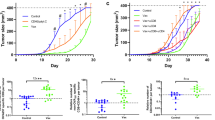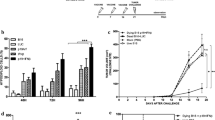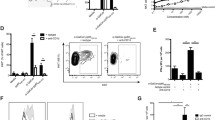Abstract
Therapeutic vaccines to induce anti-tumor CD8 T cells have been used in clinical trials for advanced melanoma patients, but the clinical response rate and overall survival time have not improved much. We believe that these dismal outcomes are caused by inadequate number of antigen-specific CD8 T cells generated by most vaccines. In contrast, huge CD8 T cell responses readily occur during acute viral infections. High levels of type-I interferon (IFN-I) are produced during these infections, and this cytokine not only exhibits anti-viral activity but also promotes CD8 T cell responses. The studies described here were performed to determine whether promoting the production of IFN-I could enhance the potency of a peptide vaccine. We report that cyclic diguanylate monophosphate (c-di-GMP), which activates the stimulator of interferon genes, potentiated the immunogenicity and anti-tumor effects of a peptide vaccine against mouse B16 melanoma. The synergistic effects of c-di-GMP required co-administration of costimulatory anti-CD40 antibody, the adjuvant poly-IC, and were mediated in part by IFN-I. These findings demonstrate that peptides representing CD8 T cell epitopes can be effective inducers of large CD8 T cell responses in vaccination strategies that mimic acute viral infections.






Similar content being viewed by others
Abbreviations
- ACT:
-
Adoptive cell therapy
- APC:
-
Antigen-presenting cell
- Bt:
-
Boost
- c-di-GMP:
-
Cyclic diguanylate monophosphate
- DC:
-
Dendritic cell
- ELISA:
-
Enzyme-linked immune assay
- EliSpot:
-
Enzyme-linked immunospot
- IFNαβR:
-
Interferon alpha–beta receptor
- IFN-I:
-
Type-I interferon
- IFNγ:
-
Interferon gamma
- i.v.:
-
Intravenous
- MDA5:
-
Melanoma differentiation-associated protein 5
- Ova:
-
Ovalbumin
- Pam:
-
Palmitic acid
- Poly-IC:
-
Polyinosinic-polycytidylic acid
- Pr:
-
Prime
- PRR:
-
Pattern recognition receptor
- STING:
-
Stimulator of interferon genes
- TLR3:
-
Toll-like receptor 3
References
Siegel R, Naishadham D, Jemal A (2013) Cancer statistics, 2013. CA Cancer J Clin 63:11–30
DeSantis CE, Lin CC, Mariotto AB, Siegel RL, Stein KD, Kramer JL, Alteri R, Robbins AS, Jemal A (2014) Cancer treatment and survivorship statistics, 2014. CA Cancer J Clin 64:252–271
Rosenberg SA, Yang JC, Schwartzentruber DJ et al (1998) Immunologic and therapeutic evaluation of a synthetic peptide vaccine for the treatment of patients with metastatic melanoma. Nat Med 4:321–327
Schwartzentruber DJ, Lawson DH, Richards JM et al (2011) gp100 peptide vaccine and interleukin-2 in patients with advanced melanoma. N Engl J Med 364:2119–2127
Smith JW 2nd, Walker EB, Fox BA et al (2003) Adjuvant immunization of HLA-A2-positive melanoma patients with a modified gp100 peptide induces peptide-specific CD8+ T-cell responses. J Clin Oncol 21:1562–1573
Mescher MF, Curtsinger JM, Agarwal P, Casey KA, Gerner M, Hammerbeck CD, Popescu F, Xiao Z (2006) Signals required for programming effector and memory development by CD8+ T cells. Immunological Rev 211:81–92
Horkheimer I, Quigley M, Zhu J, Huang X, Chao NJ, Yang Y (2009) Induction of type I IFN is required for overcoming tumor-specific T-cell tolerance after stem cell transplantation. Blood 113:5330–5339
Fuertes MB, Woo SR, Burnett B, Fu YX, Gajewski TF (2013) Type I interferon response and innate immune sensing of cancer. Trends Immunol 34:67–73
Schmeisser H, Fey SB, Horowitz J, Fischer ER, Balinsky CA, Miyake K, Bekisz J, Snow AL, Zoon KC (2013) Type I interferons induce autophagy in certain human cancer cell lines. Autophagy 9:683–696
Coit DG, Andtbacka R, Anker CJ et al (2013) Melanoma, version 2.2013: featured updates to the NCCN guidelines. J Natl Compr Canc Netw 11:395–407
Burdette DL, Monroe KM, Sotelo-Troha K, Iwig JS, Eckert B, Hyodo M, Hayakawa Y, Vance RE (2011) STING is a direct innate immune sensor of cyclic di-GMP. Nature 478:515–518
Parvatiyar K, Zhang Z, Teles RM et al (2012) The helicase DDX41 recognizes the bacterial secondary messengers cyclic di-GMP and cyclic di-AMP to activate a type I interferon immune response. Nat Immunol 13:1155–1161
Karaolis DK, Means TK, Yang D et al (2007) Bacterial c-di-GMP is an immunostimulatory molecule. J Immunol 178:2171–2181
McWhirter SM, Barbalat R, Monroe KM et al (2009) A host type I interferon response is induced by cytosolic sensing of the bacterial second messenger cyclic-di-GMP. J Exp Med 206:1899–1911
Shu C, Yi G, Watts T, Kao CC, Li P (2012) Structure of STING bound to cyclic di-GMP reveals the mechanism of cyclic dinucleotide recognition by the immune system. Nat Struct Mol Biol 19:722–724
Abe T, Barber GN (2014) Cytosolic-DNA-mediated, STING-dependent proinflammatory gene induction necessitates canonical NF-kappaB activation through TBK1. J Virol 88:5328–5341
Buteau C, Markovic SN, Celis E (2002) Challenges in the development of effective peptide vaccines for cancer. Mayo Clin Proc 77:339–349
Cho HI, Celis E (2009) Optimized peptide vaccines eliciting extensive CD8 T-cell responses with therapeutic antitumor effects. Cancer Res 69:9012–9019
Barrios K, Celis E (2012) TriVax-HPV: an improved peptide-based therapeutic vaccination strategy against human papillomavirus-induced cancers. Cancer Immunol Immunother 61:1307–1317
Cho HI, Reyes-Vargas E, Delgado JC, Celis E (2012) A potent vaccination strategy that circumvents lymphodepletion for effective antitumor adoptive T-cell therapy. Cancer Res 72:1986–1995
Cho HI, Barrios K, Lee YR, Linowski AK, Celis E (2013) BiVax: a peptide/poly-IC subunit vaccine that mimics an acute infection elicits vast and effective anti-tumor CD8 T-cell responses. Cancer Immunol Immunother 62:787–799
Muller U, Steinhoff U, Reis LF, Hemmi S, Pavlovic J, Zinkernagel RM, Aguet M (1994) Functional role of type I and type II interferons in antiviral defense. Science 264:1918–1921
Overwijk WW, Theoret MR, Finkelstein SE et al (2003) Tumor regression and autoimmunity after reversal of a functionally tolerant state of self-reactive CD8+ T cells. J Exp Med 198:569–580
Cho HI, Lee YR, Celis E (2011) Interferon gamma limits the effectiveness of melanoma peptide vaccines. Blood 117:135–144
Fortier MH, Caron E, Hardy MP, Voisin G, Lemieux S, Perreault C, Thibault P (2008) The MHC class I peptide repertoire is molded by the transcriptome. J Exp Med 205:595–610
Jedema I, van der Werff NM, Barge RM, Willemze R, Falkenburg JH (2004) New CFSE-based assay to determine susceptibility to lysis by cytotoxic T cells of leukemic precursor cells within a heterogeneous target cell population. Blood 103:2677–2682
Liu L, Chahroudi A, Silvestri G et al (2002) Visualization and quantification of T cell-mediated cytotoxicity using cell-permeable fluorogenic caspase substrates. Nat Med 8:185–189
Jin L, Hill KK, Filak H, Mogan J, Knowles H, Zhang B, Perraud AL, Cambier JC, Lenz LL (2011) MPYS is required for IFN response factor 3 activation and type I IFN production in the response of cultured phagocytes to bacterial second messengers cyclic-di-AMP and cyclic-di-GMP. J Immunol 187:2595–2601
Becker JC, Andersen MH, Hofmeister-Muller V et al (2012) Survivin-specific T-cell reactivity correlates with tumor response and patient survival: a phase-II peptide vaccination trial in metastatic melanoma. Cancer Immunol Immunother 61:2091–2103
Dangoor A, Lorigan P, Keilholz U et al (2010) Clinical and immunological responses in metastatic melanoma patients vaccinated with a high-dose poly-epitope vaccine. Cancer Immunol Immunother 59:863–873
Hinrichs CS, Rosenberg SA (2014) Exploiting the curative potential of adoptive T-cell therapy for cancer. Immunological Rev 257:56–71
Curtsinger JM, Valenzuela JO, Agarwal P, Lins D, Mescher MF (2005) Type I IFNs provide a third signal to CD8 T cells to stimulate clonal expansion and differentiation. J Immunol 174:4465–4469
Zwaveling S, Ferreira Mota SC, Nouta J, Johnson M, Lipford GB, Offringa R, van der Burg SH, Melief CJ (2002) Established human papillomavirus type 16-expressing tumors are effectively eradicated following vaccination with long peptides. J Immunol. 169:350–358
Acknowledgments
This work was supported by grants from the National Cancer Institute of the National Institutes of Health, R01CA136828 and R01CA157303, and by start-up funds from Georgia Regents University Cancer Center and the Georgia Research Alliance (GRA). We thank Ms. Diane Addis for the valuable technical expertise provided to this project and the GRU Cancer Center Flow Cytometry Core for services provided.
Conflict of interest
Esteban Celis has filed patent applications based on the use of synthetic peptides and poly-IC combinatorial vaccines. The rights of the patent applications have been transferred to the Moffitt Cancer Center (Tampa, FL). Zili Wang declares no conflict of interest.
Author information
Authors and Affiliations
Corresponding author
Rights and permissions
About this article
Cite this article
Wang, Z., Celis, E. STING activator c-di-GMP enhances the anti-tumor effects of peptide vaccines in melanoma-bearing mice. Cancer Immunol Immunother 64, 1057–1066 (2015). https://doi.org/10.1007/s00262-015-1713-5
Received:
Accepted:
Published:
Issue Date:
DOI: https://doi.org/10.1007/s00262-015-1713-5




